
Venkateswara, also known as Venkatachalapati, Balaji and Srinivasa, is a Hindu deity, described as a form or avatar of the god Vishnu. He is the presiding deity of Venkateswara Temple, Tirupati. His consorts, Padmavathi and Bhudevi, are avatars of the goddess Lakshmi, the consort of Vishnu.

Guruvayurappan also rendered as Guruvayoorappan, is a form of Vishnu worshipped mainly in Kerala, India. He is the presiding deity of the Guruvayur Temple, who is worshipped as Krishna in his child form, also known as Guruvayur Unnikkannan. The temple is located in the town of Guruvayur, Thrissur, Kerala, which is named after the deity.
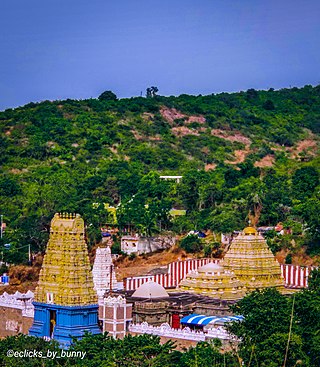
Sri Varaha Lakshmi Narasimha temple, Simhachalam, is a Hindu temple situated on the Simhachalam Hill Range,which is 300 metres above the sea level in the city of Visakhapatnam, Andhra Pradesh, India. It is dedicated to Lord Vishnu, who is worshipped there as Varaha Narasimha. As per the temple's legend, Vishnu manifested in this form after saving his devotee Prahlada from a murder attempt by the latter's father Hiranyakashipu. Except on Akshaya Trutiya, the idol of Varaha Narasimha is covered with sandalwood paste throughout the year, which makes it resemble a linga. The temple was built in Kalingan architecture styles and stands unique in the historical region of Kalinga.The Present temple was built by Eastern Ganga king Narasingha Deva I in the 13th century and consecrated by his son Bhanudeva I in 1268 CE. The temple was built by Akthayi Senapati, on the command of Narasingha Deva I.
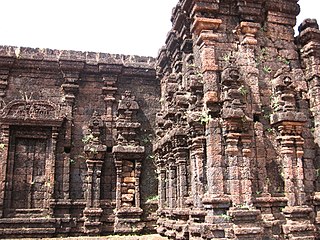
The Rajarajeshwara temple is a Shiva temple located in Taliparamba in Kannur district of Kerala State of India. The temple is regarded as one of the existing 108 ancient Shiva Temples of ancient Kerala. It also has a prominent place amongst the numerous Shiva temples in South India. It had the tallest shikhara amongst the temples of its time. The Rajarajeshwara temple has a top of about 90 tonnes. If any problem is encountered in the other temples of South India, devotees seek a solution in this temple through a prashnam, a traditional method of astrological decision-making. The prashnam is conducted on a peedha outside the temple.

Oothukkaadu Venkata Kavi or Oottukkaadu Venkata Subramanyar was one of the pioneering composers in Indian classical Carnatic music. He lived in South India in the present-day state of Tamil Nadu. Also known by the name Oothukkaadu Venkatasubramaniya Iyer, he composed hundreds of compositions in Sanskrit and Tamil of which over 500 are available. These were handed down from generation to generation by the descendants of the composer's brother's family.

The Vilwadrinatha Temple is a Hindu temple in Thiruvilwamala, a town in the city of Thrissur, Kerala, India. The principal deities are Rama, the seventh incarnation of the god Vishnu, and his brother, Lakshmana. It figures among the Abhimana Kshetrams in Vaishnavite traditions. This is one of the four major Rama temples in Kerala — the other three are in Thriprayar, Kadavallur, and Thiruvangad. The temple houses an idol of Lakshmana, which is rare in India. Vilwadrinatha Temple is located in the centre of the community of Thiruvilwamala, atop a 100-foot-high hillock. Visible from the temple is Bharathappuzha, the second-largest river in Kerala, which flows past the temple's northern side from around 3 kilometres away.
Venkateswara Temple, Tirumala a landmark Vaishnavite temple situated in the hill town of Tirumala at Tirupati in Chittoor district of Andhra Pradesh, India. The temple is dedicated to Venkateswara, an incarnation of Vishnu, who is believed to be appeared here to save mankind from the trials and troubles of Kali Yuga.
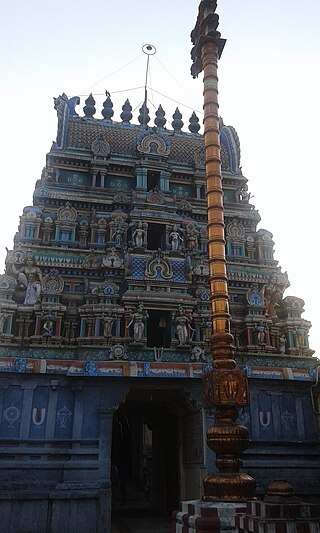
The Devaadi Raja Perumal temple in Therazhundur, a village in Mayiladuthurai district of the South Indian state of Tamil Nadu, is dedicated to the Hindu god Vishnu. Constructed in the Dravidian style of architecture, the temple is glorified in the Naalayira Divya Prabandham, the early medieval Tamil canon of the Alvar saints from the 6th–9th centuries CE. It is one of the 108 Divya Desams dedicated to Vishnu, who is worshipped as Amaruviappan, and his consort Lakshmi as Sengamalavalli Thayar. The original structure of the temple was built by the Karikala Chola during the 1st century CE, with later additions from the Cholas during the 11th century.

Thiru Anbil, or Sundararaja Perumal Temple, in Anbil, a village in the outskirts of Tiruchirappalli in the South Indian state of Tamil Nadu, is dedicated to the Hindu god Vishnu. Constructed in the Dravidian style of architecture, the temple is glorified in the Naalayira Divya Prabandham, the early medieval Tamil canon of the Alvar saints from the 6th–9th centuries CE. It is one of the 108 Divya Desams dedicated to Vishnu, who is worshipped as Sundararajan and his consort Lakshmi as Sundaravalli.

Suryanar Kovil is a Hindu temple dedicated to the deity Hindu Sun-God, Surya, located in Suryanar Kovil, a village near the South Indian town of Kumbakonam Thanjavur District in Tamil Nadu, India. The presiding deity is Suriyanar, the Sun and his consorts Ushadevi and Pratyusha Devi. The temple also has separate shrines for the other eight planetary deities. The temple is considered one of the nine Navagraha temples in Tamil Nadu. The temple is one of the few historic temples dedicated to Sun god and is also the only temple in Tamil Nadu which has shrines for all the planetary deities.

Sthalasayana Perumal Temple is a Hindu temple dedicated to the god Vishnu located near Kollumangudi, Tamil Nadu, India. It is located 2 km away from Kollumangudi, 40 km away from Kumbakonam and 10 km from Karaikal. Constructed in the Dravidian style of architecture, the temple is glorified in the Nalayira Divya Prabandham, the early medieval Tamil canon of the Alvar saints from the 6th–9th centuries CE. It is one of the 108 Divya Desams dedicated to Vishnu, who is worshipped as Sthalasayana Perumal and his consort Lakshmi as Thirumagal Nachiyar. A granite wall surrounds the temple, enclosing all the shrines. There is a four-tiered rajagopuram, the temple's gateway tower, in the temple.
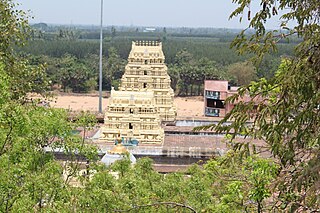
Devanatha Hemabhujavalli Temple (Thiruvaheendrapuram) is a Hindu temple in Thiruvanthipuram, a village in the outskirts of Cuddalore in the South Indian state of Tamil Nadu, dedicated to the god Vishnu and goddess Lakshmi. Constructed in the Dravidian style of architecture, the temple is glorified in the Nalayira Divya Prabandham, the early medieval Tamil canon of the Alvar saints from the 6th–9th centuries CE. It is one of the 108 Divya Desams dedicated to Vishnu, who is worshipped as Devanatha and Lakshmi as Hemabhujavalli. Though the presiding deity is Devanatha and Hemabhujavalli, the temple is known for Hayagriva, the ninth avatara of Vishnu in the Dashavatara of Vishnu and a god of knowledge. The temple is the only historical temple in South India to have a shrine of Hayagriva on hilltop.

The Saranathan Temple in Thirucherai, a village on the outskirts of Kumbakonam in the South Indian state of Tamil Nadu, is dedicated to the Hindu god Vishnu. The temple is glorified in the Nalayira Divya Prabandham, the early medieval Tamil canon of the Alvar saints from the 6th–9th centuries CE. It is one of the 108 Divya Desams dedicated to Vishnu, who is worshipped as Saranathan and his consort Lakshmi as Saranayaki. It is believed that Saranathan appeared for Kaveri, the river goddess, who performed penance at this place.
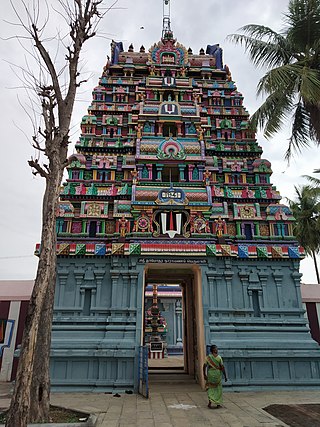
The Loganatha Perumal Temple is a Hindu temple dedicated to Vishnu located 2 km away from Sikkal, Tamil Nadu, India on the Tiruvarur-Nagapatnam highway. Constructed in the Dravidian style of architecture, the temple is glorified in the Nalayira Divya Prabandham, the early medieval Tamil canon of the Alvar saints from the 6th–9th centuries CE. It is one of the 108 Divya Desams dedicated to Vishnu, who is worshiped as Loganatha Perumal and his consort Lakshmi as Loganayagi.

The Gajendra Varadha Perumal Temple in Thirukkavithalam, a village in the outskirts of Papanasam in the South Indian state of Tamil Nadu, is dedicated to the Hindu god Vishnu. Constructed in the Dravidian style of architecture, the temple is glorified in the Nalayira Divya Prabandham, the early medieval Tamil canon of the Alvar saints from the 6th–9th centuries CE. It is one of the 108 Divya Desams dedicated to Vishnu, who is worshipped as Gajendra Varadha Perumal and his consort Lakshmi as Ramamanivalli. The temple is one of the five Pancha-Kannan temples, where Krishna, an avatar of Vishnu is given prominence over the presiding deity.

Sri Lakshmi Narasimhar Temple is located about 55 km from Chennai and 21 km from Arakkonam, in Narasingapuram, Thiruvallur. The temple is dedicated to Hindu deity Narasimha, who is avatar of Vishnu and his consort Lakshmi. From the days of glory and grandeur that prevailed in South India the temple of Lakhsmi Narasimha at Narasingapuram still boasts the era of Cholas and Vijayanagara Rayas. The Lakshmi Narasimha Temple is situated in the village of Narasingapuram in Thiruvallur district.
Venkateswara Temple is an important Vaishnavite temple situated in the hill town of Tirumala in Tirupati of Andhra Pradesh, India. The Temple is dedicated to Venkateswara, an incarnation of Vishnu, who is believed to have appeared here to save mankind from the trials and troubles of Kali Yuga. The temple is situated at a height of 853 m (2,799 ft) on Tirumala Hills which are part of the Seshachalam Hills and is constructed in Dravidian architectural style.

Sri Veera Venkata Satyanarayana Swamy Temple is a Hindu-Vaishnavite temple located in Annavaram in Kakinada district of Andhra Pradesh, India. Dedicated to Lord Satyanarayana Swamy, an incarnation of Lord Vishnu, the temple is situated on Ratnagiri Hill. It is one of the most visited religious sites in Andhra Pradesh and is recognized as one of the state's wealthiest temples. The temple holds significant importance as a major pilgrimage centre and is regarded by many as the second most prominent in the state after the Tirumala Venkateswara Temple.

Veerateeswarar Temple is a Hindu temple located at Korukkai in Mayiladuthurai district of Tamil Nadu, India. The presiding deity is Shiva in the form of Veerateswarar and his consort is known as Gnanambigai. The presiding deity is revered in the 7th century Tamil Saiva canonical work, the Tevaram, written by Tamil saint poets known as the nayanars and classified as Paadal Petra Sthalam, the 276 temples that find mention in it.
The Yogananda Lakshmi Narasimha Swamy Temple, also known as Mattapalli Narasimha Temple, is a Hindu temple dedicated to Narasimha, the half-man half-lion avatar of Vishnu, and his consort Lakshmi. It is located in Mattampally, a village in the Mattampally mandal of Suryapet district in the Indian state of Telangana. One of the Pancha Narasimha Kshetras, the temple is located on the banks of the Krishna River, and was built in the 11th century by Anumala Machi Reddy, the king of Thangedu region after the deity appeared in his dream and instructed him to do so. The main shrine houses a swayambhu (self-manifested) idol of Narasimha as Yogananda Lakshmi Narasimha, and was worshipped by sage Bharadvaja and other seers for hundreds of years before the temple was constructed. Lakshmi is worshipped here as Rajalakshmi Thayar and Chenchu Lakshmi Thayar.

















